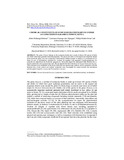| dc.contributor.author | Makenzi, A. M. | |
| dc.contributor.author | Manguro, L. O. A. | |
| dc.contributor.author | Owuor, P. O. | |
| dc.contributor.author | Opiyo, Sylvia A. | |
| dc.date.accessioned | 2019-11-20T16:08:58Z | |
| dc.date.available | 2019-11-20T16:08:58Z | |
| dc.date.issued | 2019-10 | |
| dc.identifier.citation | Bull. Chem. Soc. Ethiop. 2019, 33(3), 527-539 | en_US |
| dc.identifier.uri | https://www.ajol.info/index.php/bcse/article/view/191196 | |
| dc.identifier.uri | http://hdl.handle.net/123456789/4373 | |
| dc.identifier.uri | https://dx.doi.org/10.4314/bcse.v33i3.13 | |
| dc.description | DOI: https://dx.doi.org/10.4314/bcse.v33i3.13 | en_US |
| dc.description.abstract | The genus Ocimum belongs to the Lamiaceae family and is made of almost 200 species of herbs and shrubs which have potential medicinal properties. The species are native to the tropical and temperate climate zones around the globe. Two new compounds with damarane skeleton namely 2α-hydroxy-3-oxodammara-20,24-diene (1) and 2α,3β-dihydroxy dammara-20, 24-diene (2) together with apeginin7-O-neohespeiridoside (3), quercetin (4), turkesterone (5), fesitin (6), apeginin (7), chrysin (8), lupeol (9), stigmasterol (10), friedelin (11), α-amyrin acetate (12) and n-octacosonoic acid (13) are reported here from the leaves of Ocimum kilimandscharicum. Their structures were established on the basis of physical and spectroscopic analyses and by comparison with the literature data. Crude extracts and isolated compounds were investigated for contact toxicity and anti-feedant activity against Sitophilus zeamais and Prostephanus truncatus. | en_US |
| dc.language.iso | en | en_US |
| dc.publisher | Chemical Society of Ethiopia | en_US |
| dc.subject | Ocimum kilimandscharicum | en_US |
| dc.subject | Lamiaceae | en_US |
| dc.subject | Contact toxicity | en_US |
| dc.subject | Anti-feedant activity | en_US |
| dc.subject | Acclimatized | en_US |
| dc.title | Chemical Constituents of Ocimum Kilimandscharicum Guerke Acclimatized In Kakamega Forest, Kenya | en_US |
| dc.type | Article | en_US |

